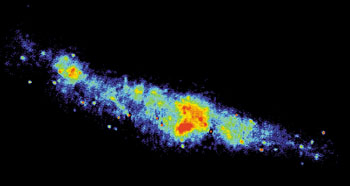
A nearby active galaxy reveals a unique population of exploding stars. Astronomers at the UK’s Jodrell Bank radio astronomy laboratory have observed over 50 supernova remnants in the galaxy M82. These shells of gas are blasted into space during the giant explosion at the end of a massive star’s lifetime.
For the first time, the astronomers can resolve the individual shells and measure their expansion in a galaxy 10 million light years from our own. They can also measure their luminosity. The 50 supernova remnants are ideal candidates for this kind of population study as they are all at essentially the same distance, unlike the supernovae observed in our own galaxy.

M82 is a “starburst” galaxy with a central region of intense star formation. Mapping the absorption of hydrogen gas in front of the supernovae gives clues to how this activity in the centre is fueled.
The study of supernovae has important consequences for cosmology as certain supernovae are used as standard candles to measure distances in space. Spectral studies of supernova remnants reveal how heavy elements are distributed.
Jodrell Bank is the control centre of the MERLIN radio interferometer, comprising seven radio telescopes stretching from Manchester to Cambridge.





